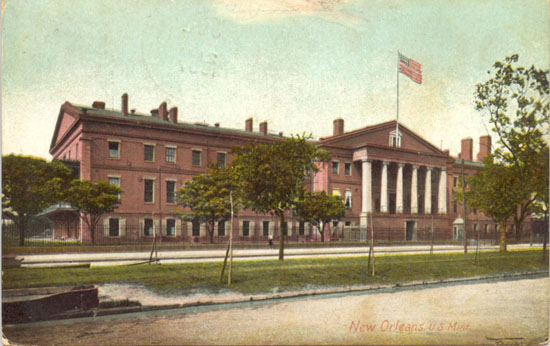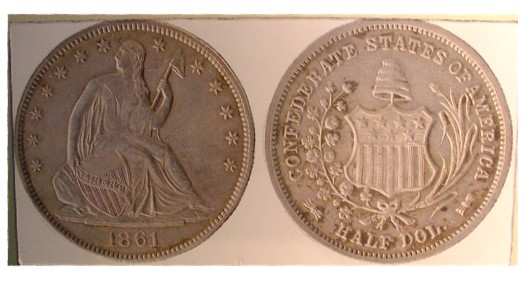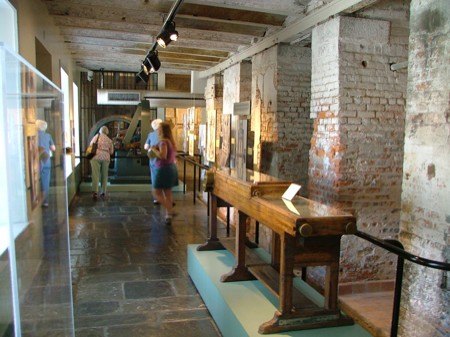New Orleans US Coin Mint
The US Mint of New Orleans has perhaps one of the most interesting histories out of all the mints. At one point, it was taken over and the United States of America no longer held control of it due to the Civil War. The New Orleans Mint officially became a branch mint on March 3, 1835 and first produced coins in 1838, staying in operation until 1861 when the war started. After the Reconstruction period, it began operations again in 1879 up until 1909. Even after it was decommissioned, the building was used as an assay office, storage facility for the US Coast Guard and even a fallout shelter. It was also damaged recently due to Hurricane Katrina. This National Historic Landmark is actually the oldest surviving building that was originally a US Mint.
The founding of the New Orleans mint in strategic location
New Orleans was founded in 1718 and was a great commercial hub because it was at the mouth of the Mississippi River and is located on the coast of the Gulf of Mexico. Therefore it was a commercial strategic location, a large amount of gold passed through the city ports each year from Mexico, it was located near a natural gold deposits in Alabama, New Orleans was the fifth largest city in the country at the time, it processed more foreign trade than any of the other cities in the US and therefore the US government made it a branch mint on March 3 of 1835. There were two other smaller and less known mints of Charlotte Mint and Dahlonega Mint in the south as well.

United States President Andrew Jackson had a large influence in the creation of this mint. In 1832, he used his veto power to prevent a rechartering of what was an institution known as the Second Bank of the US. He also used an executive order known as Specie Circular, which required that any land transactions had to be paid in cash. These fiscal policies along with an economic depression was largely responsible for the Panic of 1837, which then created a large need for more minted cash, which was another reason to create a new mint.
The two smaller mints struck only gold coins, but since the Philadelphia Mint could not disperse their coins quick enough to the farther reaches of the frontier, New Orleans became the most important branch mint in the nation and so they minted not only gold coins but also silver. The location of the mint itself was on the northeastern part of the French Quarter, which was designed by the in a Greek Revival style with red brick by the architect William Strickland. Strickland also designed the Philadelphia Mint's second building and he was taught by Benjamin Latrobe, the designer of the US Capital building of Washington D.C.
Unfortunately, William Strickland did not consider the terrain that this building was going to be constructed on. The land itself is a swampy lowland area with a high water table, which was characterized during the Hurricane Katrina disaster in modern times. The New Orleans coin mint started receiving structural problems and sinking into the soil. The building was later reinforced with iron rods that were put in between floors. Pierre Gustave Toutant Beauregard, a West Point graduate of engineering and Louisiana native, was giving the task to rebuild some of the arches in the ceiling of the basement and install a new masonry flooring to support the building in 1854. Also, the heavy machinery was later converted to newer steam power and a smokestack was built to vent fumes.
Ironically, Beauregard would actually become the Confederate General who would, in April of 1861, launch the attack on Fort Sumter in Charleston, South Carolina and propel the nation into the Civil War.
The New Orleans mint in the Civil War and Confederate Control
The first coin minting operations at New Orleans began on March 8 of 1838 from Mexican gold bullion. It is recorded that the first coins ever minted here were just 30 dimes on May 7. They went on to mint everything from silver 3 cent pieces, silver dollars and gold dollars. One notable person who worked for the mint was John Leonard Riddell. He was a refiner and smelter between the years of 1839 and 1848. He had interests in physics, chemistry, geology, medicine and botany. He was also the inventor of binocular microscopes, wrote books called "Monograph of the Silver Dollar", "Good and Bad", "Illustrated with Facsimile Figures" and "The Mint at New Orleans - Processes Pursued of Working the Precious metals - Statistics of Coinage". His books were basically numismatic related writings.
Before the American Civil War, the US mint in New Orleans was in operation from 1838 to January 26 of 1861, which was the day Louisiana seceded from the Union. 3 days later on January 29, a Secession Convention met up in this city and allowed federal employees to stay but they would be employees of Louisiana. Finally in March, the state accepted the Confederate States Constitution and the New Orleans mint continued operation. In fact, a large number of the 1861-O Seated Liberty Half Dollars were struck by the Confederates, but no one knows how many of those 2.5 million coins were struck under United States control or from the Confederates. Eventually that year, they changed the reverse dies for the coins and struck their own coins. Only 4 of these are known to exist and one coin was once owned by Jefferson Davis, the only President of the Confederacy.

They struck coins until April 1 when the bullion needed for the coins ran out. The employees stayed until the end of May and then the mint was used to house the troops until the Union Navy commanded by Admiral David G. Farragut captured it and raised the US flag on the building in April of 1862. In the south, the mint itself was a symbol of the hatred towards the Union. William B. Mumford, a steamboat gambler, tore down the flag and ripped it to pieces. General Benjamin Franklin Butler ordered the execution and hanging of Mumford on the flagstaff, horizontally off the New Orleans mint building on June 7 of 1862. The execution made national headlines and General Butler gained the nickname of "Spoons" for pocketing spoons and silverware of those committed of treason.
New Orleans US Coin Mint recaptured by the Union
The mint finally reopened in 1876 as an assay office after the war and reconstruction period. The mint was damaged because of the war so they reported the condition of the mint and had new equipment brought in and the mint was fully repaired. Minting activity resumed in 1879 of mostly silver coins and the famous Morgan Silver Dollar between the years of 1879 and 1904. In 1907, the New Orleans mint struck 5.5 million coins for the Mexican government for a program to produce foreign coins for other nations. All coins hold the big "O" mintmark, although they had a reputation for producing coins with mediocre quality compared with the other mints. This also means that coin collectors with good quality New Orleans coins own valuable and prized coins because there are so few of them.

The working conditions at this mint were unexpectedly tough. Originally, only men worked at the mint but after the war, more and more women became involved in the operations. The climate in this area of the country was very warm, wet and humid, so they usually kept the windows open to cool off the building. The problem was that even a small draft of wind would upset the fine adjustments, weights and scales of the silver dust needed for coin planchets. Some of the dust would blow away, making the job extremely frustrating. So they had to close the doors and windows to prevent the wind. By doing this, it became extremely hot in the building and workers began dehydrating, so they needed water coolers to help cool them off. Still, this was considered good working environment for women during this time period of the late 1800s.
The decommissioning and future of the New Orleans Mint
When the 1900s came along, there was the Philadelphia, Denver Mint and San Francisco Mint, which were more than enough to create sufficient coins. So in 1904, the US government stopped minting silver dollars, which was the main coin that New Orleans produced. In 1909, the Treasury stopped operations by cutting funding and the mint was formally decommissioned in 1911 after years of faithful service, which was a sad event for Louisiana citizens at the time. The machines were then transferred to Philadelphia.
The mint had been downgraded to the status of assay office once again and in 1932, the building was turned into a prison until 1943. Then the Coast Guard took over the building and used it for storage before it was abandoned and began to decay until the State of Louisiana took control of the building from the federal government in 1965. When the Cold War started to become more frightening and the risk of nuclear war came upon the nation, the old New Orleans mint building became a fallout shelter. Finally, the building was set to be demolished unless the building was renovated within 15 years.
Renovation of the Mint and Museum of New Orleans
During the years between 1978 and 1980, the building was renovated and converted into a museum as it rightfully should have been. Other exhibitions and museums were stored that included Mardi Gras, Jazz Music, Paintings and art, Newcomb pottery, maps and documents and colonial records from the French and Spanish. This building is also part of a system of other museums in the French Quarter as well.

The newest history relating this building was written in 2005 during Hurricane Katrina. The building itself suffered heavy roof damage and flooding as many buildings did in New Orleans. Water damaged 3% of the Jazz Collection, which are now in restoration at Louisiana State University. The building was weatherproofed in 2006 and there was a structural restoration project that was to last one year. The museum was closed to the public until October 20 of 2007 when they displayed gold coins and other artifacts of natural history. They also reopened the display of minting machines on the ground floor.
Interesting Facts and Coin Statistics of the New Orleans Mint
Total Number of US Coins Ever Minted in New Orleans = 420,370,133
Over 420 MILLION Coins were minted in New Orleans and that only includes the official US currencies. As you can see, most of these coins were silver dollars, the crown jewel coin of this mint. This impressive number was during a time without modern equipment as well. These figures come from adding up all of the mintages in our database from this particular mint, which does not include the coins that had "N/A" or unknown mint figures. So the number above is conservative and the total number of coins ever minted in New Orleans throughout the entire history of the United States of America is at least this much!
Total Number of Three Cent Pieces Ever Minted in New Orleans = 720,000 face value worth $21,600
Total Number of Half Dimes Ever Minted in New Orleans = 16,280,000 face value worth $814,000
Total Number of Dimes Ever Minted in New Orleans = 68,131,834 face value worth $6,813,183
Total Number of Quarters Ever Minted in New Orleans = 60,386,000 face value worth $15,096,500
Total Number of Half Dollars Ever Minted in New Orleans = 81,389,757 face value worth $40,694,879
Total Number of Dollars Ever Minted in New Orleans = 187,111,529 face value worth $187,111,529
Total Number of Gold Dollars Ever Minted in New Orleans = 1,004,000 face value worth $1,004,000
Total Number of $2.50 Gold Quarter Eagles Ever Minted in New Orleans = 1,205,263 face value worth $3,013,158
Total Number of $3 Gold Coins Ever Minted in New Orleans = 24,000 face value worth $72,000
Total Number of $5 Gold Half Eagles Ever Minted in New Orleans = 925,145 face value worth $4,625,725
Total Number of $10 Gold Eagles Ever Minted in New Orleans = 2,361,089 face value worth $23,610,890
Total Number of $20 Gold Double Eagles Ever Minted in New Orleans = 831,516 face value worth $16,630,320